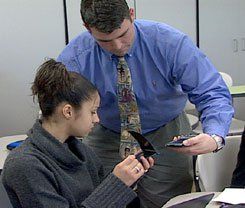This post is the third in a series exploring common misconceptions about how students learn as well as integrating Technology into the classroom. We first touched on these misconceptions and integration technology in our March 2022 report, "The Social Studies of Learning (American History)", it is clear that students respond to various types of learning styles. Thus, it is the implementation of using technology to enhance the students (participation, engagement, etc.) Learning experience(s).
In today’s post, Dr. Dylan Wiliam explores what the research tells us about how using technology influences learning styles. Dr. Dylan Wiliam is an Emeritus Professor of Educational Assessment at the Institute of Education, University College London. He served as dean and head of the School of Education at King’s College London, senior research director at the Educational Testing Service in Princeton, New Jersey, and deputy director of the Institute of Education, University of London. Since 2020, he has devoted most of his time to research and teaching.
https://youtu.be/4jLKL2VCZrA?t=107
The first step in successful tech integration is recognizing the change that may need to happen inside of yourself and in your approach to teaching. When any teacher brings technology into the classroom, he or she will no longer be the center of attention. The level of refocused attention will, of course, depend on the amount and the type of technology (e.g., mobile device, e-reader, laptop, interactive whiteboard) being brought into the classroom. However, this does not mean that the teacher is no longer essential to the learning process. While students may be surrounded by technology at home, it is dangerous to assume that they know how to use it for learning -- this is commonly referred to as the "myth of the digital native," and you can read more about it in this Edutopia blog post: "Digital Native vs. Digital Citizen? Examining a Dangerous Stereotype." Most students still need a guide to help them use digital tools effectively for learning and collaboration.
If your class has an interactive whiteboard and projector:
- Try interactive websites such as BrainPOP.
- Dig into Scholastic's whiteboard activities page.
- Show online videos related to the lessons.
- Explore virtual math manipulatives.
- Check out the native software that came with the board.
- Use the videoconferencing tool Skype to connect beyond the classroom.
If there is only one computer in your room:
- All of the above, plus…
- Assign one student to be the class scribe and take notes.
- Start a collaborative class blog.
- Check out the Skype an Author Network website.
- Try Voicethread, a collaborative multimedia conversation tool.
- Let students access review or intervention materials on a rotating schedule.
- Curate resources for students via a Livebinder.
- Build a Google Site to house class content.
- Encourage skills practice, research, or the creation of collaborative stories using Google Docs.
- Record Screencasts for providing onscreen instruction.
- Find more free resources and ideas from this Edutopia blog post.
If you have a pod of three to five computers in the classroom or access to a library with a pod of computers:
- All of the above, plus…
- Encourage individual student blogging using Kidblog.
- Have students create digital stories using Voicethread.
- Explore student-created multimedia presentations using Microsoft PowerPoint, LibreOffice, Prezi, or Google Docs.
- Use Edmodo, Schoology, or Moodle to manage course content, assignments, and assessments.
- Get the students to create cartoons using ToonDoo.
- Have students make videos using Windows Movie Maker or Animoto.
- Build websites with students using Weebly or Wikispaces.
If you have access to a laptop cart or a computer lab:
- All of the above, plus…
- Enable students to work through course content at their own pace through the use of screencasts, e-books, and other digital media.
- Use Poll Everywhere or Socrative to poll students.
- Start live class discussions with TodaysMeet.
- Explore enhanced digital note taking with Evernote.




Comments
Post a Comment